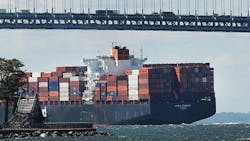Double Digit Growth in Imports Despite Tariff and Border Tax Talk
As a growing economy increases the demand for affordable merchandise, imports at the nation’s major retail container ports should see double-digit year-over-year increases for the next two months, according to the monthly Global Port Tracker report released recently by the National Retail Federation (NRF) and Hackett Associates.
“Consumers are spending more freely and retailers are stocking up for the spring and summer seasons,” said Jonathan Gold NRF vice president for Supply Chain and Customs Policy. “Merchants are making sure they are prepared to meet growing demand, and imports are essential to providing American families with the products they need at prices they can afford.”
Ports covered by Global Port Tracker handled an unusually high 1.67 million Twenty-Foot Equivalent Units in January, the latest month for which after-the-fact numbers are available. The large volume came as factories in Asia shipped a surge of products ahead of Lunar New Year shutdowns and was up 6.5% from December and 12.5% year-over-year. One TEU is one 20-foot-long cargo container or its equivalent.
February was estimated at 1.61 million TEU, up 4.2% from last year. March is forecast at 1.46 million TEU, up 10.6% from last year; April at 1.59 million TEU, up 10.1%; May at 1.67 million TEU, up 2.9%; June at 1.66 million TEU, up 5.5%, and July at 1.71 million TEU, up 5.2%.
The first half of 2017 is expected to total 9.7 million TEU, up 7.4% from the first half of 2016. Cargo volume for 2016 totaled 18.8 million TEU, up 3.1% from 2015, which had grown 5.4% from 2014.
“The threat of a border adjustment tax, withdrawal from the Trans-Pacific Partnership and a possible rewrite of the North American Free Trade Agreement might eventually dampen the trading spirit and discourage international trade,” Hackett Associates Founder Ben Hackett said. “In the meantime, the opposite is happening – trade is continuing to grow despite these developments in Washington.”
NRF has forecast that job and income growth coupled with low debt will drive 2017 retail sales – excluding automobiles, gasoline and restaurants – to increase between 3.7% and 4.2% over 2016. Cargo volume does not correlate directly with sales because only the number of containers is counted, not the value of the cargo inside, but nonetheless provides a barometer of retailers’ expectations.
